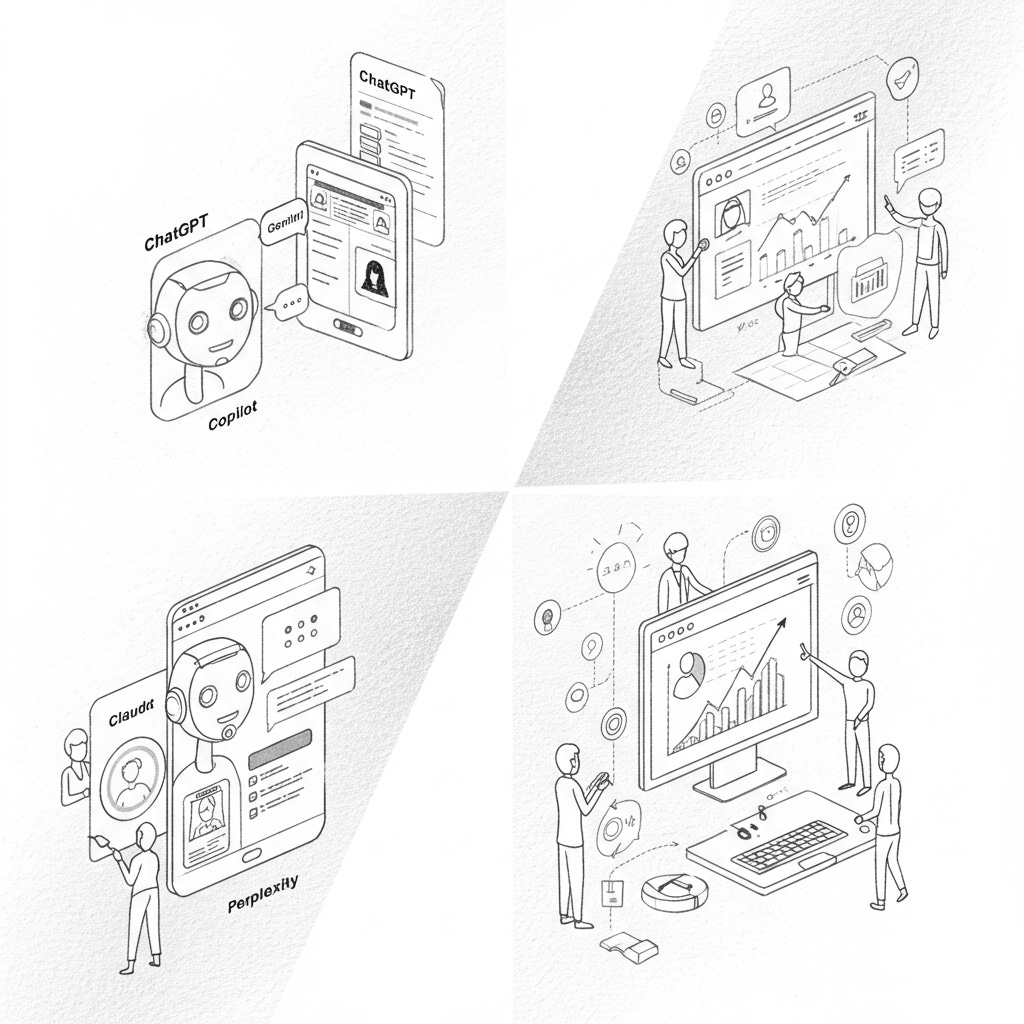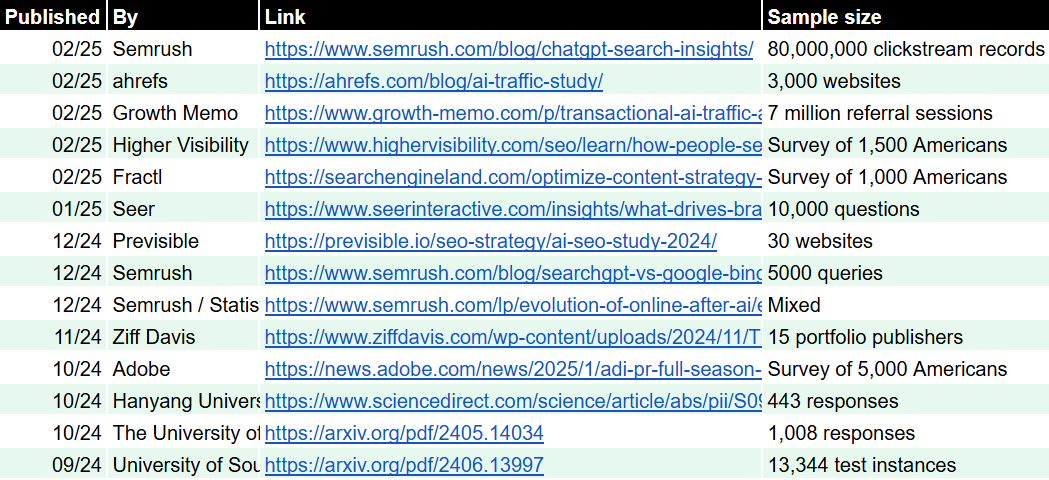The State Of AI Chatbots And SEO

Author: Super Admin
Published On: 25 February, 2025
Last week, I published a meta-analysis of AI Overviews and their impact on SEO.
Today, I publish an analysis of the research on AI chatbots and their potential impact on customer acquisition and purchase decisions.
 Image Credit: Lyna ™
Image Credit: Lyna ™I’ve analyzed 14 studies and research papers to answer five key questions:
This analysis is perfect for you if you:
I don’t include AI Overviews in this analysis since I’ve covered them in depth in last week’s Memo.
Sources:
 Image Credit: Kevin Indig
Image Credit: Kevin IndigGet the spreadsheet.
While AI chatbot traffic currently represents a tiny percentage of overall traffic, the data shows early evidence for the value of citations and mentions.
AI chatbot adoption is skyrocketing, referral traffic to websites is growing, and traffic quality is high.
ChatGPT has over 400 million weekly users as of January 2025.1
Semrush, 12/24: Most ChatGPT users are from the U.S. (25%) or India (12%), followed by India, Brazil, the UK and Germany. 70% are male, and over 50% are between 18 and 34 years old.
Higher Visibility, 02/25: 71.5% of consumers use ChatGPT for searching but complementary to Google, not as a replacement.
Ahrefs, 02/25: 63% of websites receive at least some traffic from AI sources. Only 0.17% of total visits came from AI Chatbots, with top sites achieving up to 6%.
Semrush, 02/25: The generative AI market was valued at $67 billion in 2024 and is expected to grow annually by 24.4% through 2030.
Semrush, 12/24: ChatGPT referrals to websites grew by 60% between June and October.
Semrush, 02/25: ChatGPT’s reach has expanded dramatically, sending traffic to over 30,000 unique domains daily in November 2024, up from less than 10,000 in July.
Growth Memo, 02/25: The quality of AI chatbot traffic is superior in several key metrics:
Adobe, 10/24: 25% of Britons use AI while shopping online.
In an Adobe survey of 5,000 U.S. consumers, 7 in 10 respondents who have used generative AI for shopping believe it enhances their experience. Additionally, 20% of respondents turn to generative AI to find the best deals, followed by quickly finding specific items online (19%) and getting brand recommendations (15%).
Semrush, 02/25: 46% of ChatGPT queries use the Search feature.
The research paper “A comparative study on the effect of ChatGPT recommendation and AI recommender systems on the formation of a consideration set” by Chang et al. looked at 471 consumers to understand:
Results:
Improving AI chatbot visibility is a mix of known and new levers.
Being visible on AI chatbots starts with being visible to their crawlers. Crystal Carter, head of SEO Commus at Wix, calls this “retrievability.”
Groomed XML sitemaps, strong internal linking, fast server response, and clean HTML are a good start.
LLM crawlers are less forgiving than Google when it comes to JavaScript and client-side rendering for critical SEO components. Avoid at all cost!
Ziff Davis, 11/24: A Ziff Davis study compares Domain Authority in curated (OpenWebText, OpenWebText2) with uncurated public web indices (Common Crawl, C4) to investigate how major AI companies like OpenAI, Google, and Meta trained their large language models. The unsurprising conclusion is that AI developers prefer curated text to train their models, naturally giving commercial publishers more visibility.
Semrush, 12/24: Google tends to show larger domains, ChatGPT smaller ones. The opposite is true for transactional searches: Search GPT prefers larger domains, Google smaller ones.
Seer, 01/25: Backlinks showed no correlation with AI chatbot visibility.
Seer, 01/25: Brands ranking on page 1 of Google showed a strong correlation (~0.65) with LLM mentions. Bing rankings also mattered, but a little less (~0.5–0.6).
Semrush, 02/25: The overlap between Google, Perplexity, and ChatGPT search is low (25-35% on average). However, the overlap between ChatGPT search and Bing is much higher (average = 7 domains) than with Google (4 domains).
Semrush, 02/25: YouTube is the third largest domain by referral traffic from ChatGPT. Facebook, LinkedIn, and GitHub are in the top 10.
Growth Memo, 02/25: Amazon, eBay, and Walmart dominate in Google Search just as much as in AI chatbots.
Consumers use AI chatbots differently than Google unless they turn on search features.
Semrush, 02/25: 70% of ChatGPT queries represent entirely new types of intent that don’t fit traditional search categories (navigational, informational, commercial, transactional).
Higher Visibility, 02/25: People use different AI chatbots for different user intents, e.g., Google for initial product research, ChatGPT for product comparison, and Instagram for discovering new products. However, almost 80% stick to traditional search engines for informational searches.
Growth Memo, 02/25: AI chatbots send significantly more traffic to homepages (22% on average) compared to Google (10%) yet still maintain higher engagement metrics. This trend suggests that AI chatbots are effectively preparing users for brand interactions.
AI chatbots make for a compelling marketing channel but put marketers in front of tracking and bias problems.
We can track the referral source for almost all AI chatbots, but some traffic can still fall into the direct traffic bucket.
Citations in ChatGPT typically include a “utm_source=chatgpt.com” parameter, but links in search results don’t have the parameter.2
Ahrefs, 02/25: AI traffic is likely underreported because AI chatbots like Copilot get clustered into direct while they’re actually referrals.
Semrush, 12/24: Consumers and users are skeptical about AI output. 50% say they trust it more when it’s been reviewed by a human.
In the paper “Global is Good, Local is Bad?” Kamruzzaman et al. conducted experiments with fill-in-the-blank questions across four product categories and 15 countries (English only). The researchers studied the effect of:
Results:
The underlying reasons are that local brand names are underrepresented in LLM training data, and large companies can afford larger marketing campaigns and, therefore, create more bias.
In the paper “Generative AI Search Engines as Arbiters of Public Knowledge: An Audit of Bias and Authority” by Li et al., researchers tested how ChatGPT, Bing Chat, and Perplexity answer questions about four major topics: climate change, vaccination, alternative energy, and trust in media. They wanted to see if the AI showed bias in its answers and how it tried to appear trustworthy.
The results:
The data we have today shows that AI chatbots are developing into a significant customer acquisition channel with many familiar mechanics.
However, their task-based nature, bias, and demographics suggest we should be cautious when using the same approach as classic search engines.
Don’t forget – Search is just a means to an end. Ultimately, people search to solve problems, i.e., do tasks.
The fact that AI chatbots can skip the search part and do tasks on the spot means they’re superior to classic search engines. For this reason, I expect Google to add more agentic capabilities to AI Overviews or launch a new Gemini-based product in Search.
The underlying technology allows AI chatbots to fork off search engine ranks and develop their own signals. And it evolves rapidly.
The evolution so far went from machine learning in the pre-2022 era to early LLMs and now inference models (think: reasoning).
Better reasoning allows LLMs to recognize user intent even better than classic search engines, making it easier to train models on better sources to mention or cite.
This brings me to the question of whether Google/Bing incumbents will also dominate AI chatbots down the road. Right now, the answer is yes. But for how long?
Generational preferences could be the biggest driver of new platforms. The easiest way for Google to become irrelevant is to lose young people.
There is a chance that multimodality will quickly play a more prominent role in AI chatbot adoption. So far, text interfaces dominate.
But Google already reports 10 billion searches with Google Lens, and Meta’s Ray Ban smartglasses are very successful. Other than Google Search, the LLM answer format is easy to transport to other devices and modalities, which could transform AI.3
Boost your skills with Growth Memo’s weekly expert insights. Subscribe for free!
1 ChatGPT now has 400 million weekly users — and a lot of competition
2 Deep Dive: Tracking How ChatGPT + Search & Others Send Users To Your Site
3 Google Lens Reaches 10 Billion Monthly Searches
Featured Image: Paulo Bobita/Search Engine Journal